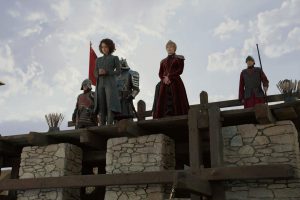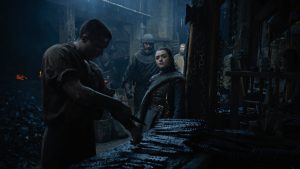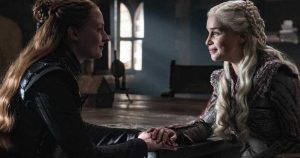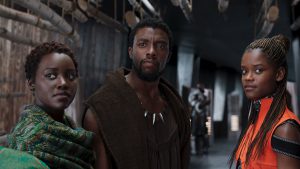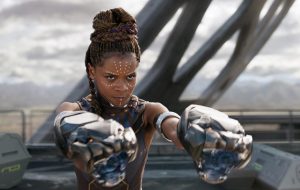Ash Tyler and Voq – are both captivating characters. Shazad Latif performs both. Each of them in their own specific guise is a central figure within the main cast of season one and two of Star Trek Discovery (USA 2017-). The Klingon Voq und the human Ash Tyler represent the story’s antagonistic conflict – those who are involved in a war with each other. How the creators of the series, Bryan Fuller and Alex Kurtzman, and their team[1] designed Voq and Ash Tyler as characters, is of particular interest for this text from a dramaturgical point of view.
To contextualise the following discussion, I will give first a short summary of the dramaturgical context. As widely known, a combination of storytelling approaches can enrich productions by applying postmodern film aesthetics thus offering a specifically unique appeal.[2] One of these dramaturgical options is that of the ’split/doubled protagonist‚. This allows for the provision of an inner self, an inner conflict with its richness of character traits, and other ways to define a personality or a personification.[3] The other aesthetic approach of interest here is a film-dramaturgical variant of the ‚unreliable narration‘ which has its origins in literature studies.[4]
These stylistic/dramaturgical methods of ‘unreliable narration’ were already used in SHUTTER ISLAND (Martin Scorsese), A BEAUTIFUL MIND (Howard), THE USUAL SUSPECTS (Singer) as well as in SHINING (Kubrick). In these movies; the writer/directors also operate with split or double characters. The protagonists of these films either imagine another character relevant to the plot or they evoke this character as a presumed real figure for the characters involved in the action. The very first split character was invented by Heinz Ewers and Paul Wegener for DER STUDENT VON PRAG (Wegener und Rye). In this movie, the main character (Paul Wegener) sells his own mirror image which transforms itself into a negative minded version of himself. Another example is ORLANDO (Potter UK/RUS/I/F/NL 1992), based on the novel by Virginia Woolf.[5] In this story, the central character is designed as two different manifestations of itself, both played by Tilda Swinton. The Orlando of the first half of the film is male and transforms into a female character for the second half. Another example, also relevant to the construction of Voq/Ash Tyler is Kubrick’s Danny (Danny Lloyd) in SHINING. Danny imagines Tony, his friend, who speaks through him.[6] Tony is not exclusively in dialogue with Danny. In A BEAUTIFUL MIND or SHUTTER ISLAND, the doubled character is only visible to the main character. Tony answers Danny’s mother as well when asked. Later in the movie, Tony takes over Danny and his body.
In film productions, writers and directors often combine a split and/or doubled protagonist with the possibilities of an aesthetic strategy based on ‚unreliable narration‘.[7] For movies like these – on the explicit level -, one constructs the cinematic plot in such a way that this initially seems in keeping with the narrative convention of the respective genre. However, in a key scene, the double perspective which is the result of the specific disposition given to the split/doubled character(s) is (more or less) revealed. One can set this key scene either within the middle of the story as part of the peripeteia (the moment of recognition)[8] or during the denouement (also known as ‘showdown’)[9]. Consequently, the previous action appears in a new light, and the audience must reconsider what it believes has been happening and understood so far.
The challenge and art of applying postmodern film dramaturgy to a production require integrating all references and hints/clues into the filmic narrative without imposing these too early.
As mentioned above, a variation of the doubled, split protagonist is the character Voq/Ash Tyler (Shazat Latif), which is central to the plot of the STAR TREK DISCOVERY series. In the following, I will restrict myself to the most relevant scenes in order to outline how this principle was utilised.
In Season 1, the figure going by the name Voq is relevant for the explicit dramaturgy of the overall action at the beginning of the series, and not only for the vertical level of the Klingon-story although it is placed within this narrative thread. The Klingons are introduced as antagonists to the Federation of Planets – those who want war against those who ‚come in peace‘. This character going with the name Voq is central to the construction of the conflict, as well as to the main plot’s horizontal dramaturgy for season one and two.
Resulting from the sequence of events arranged for the Klingon sub-story, this Voq gets banished from the Klingon Empire, a quasi-condemnation to death. Left alone at the abandoned ship he is shown speaking to himself – and hence to the audience: “They left me here to die (…).”[10] I mmediately after this sentence, we see his beloved Klingon princess L’Rell (Mary Chieffo) arriving. Since we know already that she loves him, she offers to save him, but the price Voq must pay is high. L’Rell was introduced at this point as a reliable and powerful character who is able to utilise her skills and opportunities. To present her commitment and then to make this character disappear would not have met the dramaturgical quality of the composition up to this point. Thus, Voq as the character must sacrifice everything, and in this way, the information is passed onto us as the audience.[11] This is one of the key hints. This intervention is not to be underestimated. The series is from the viewpoint of the dramaturg well composed and written, has a good rhythm supporting the postmodern aesthetics and approach, as well as being well directed and edited.
mmediately after this sentence, we see his beloved Klingon princess L’Rell (Mary Chieffo) arriving. Since we know already that she loves him, she offers to save him, but the price Voq must pay is high. L’Rell was introduced at this point as a reliable and powerful character who is able to utilise her skills and opportunities. To present her commitment and then to make this character disappear would not have met the dramaturgical quality of the composition up to this point. Thus, Voq as the character must sacrifice everything, and in this way, the information is passed onto us as the audience.[11] This is one of the key hints. This intervention is not to be underestimated. The series is from the viewpoint of the dramaturg well composed and written, has a good rhythm supporting the postmodern aesthetics and approach, as well as being well directed and edited.
In episode 5 of season one, we see Captain Lorca (Jason Isaak), this time acting captain of the Discovery, kidnapped by the Klingons. When the captain arrives in their prison, he meets a new character: Ash Tyler. The story which establishes this character tells us that he was captured by the Klingons during ‘the battle at the Binary Stars’, which took place in episode 2. Part of the dialogue and background information given to increase the tension, tells us that although the Klingons kill most of their prisoners of war randomly, he managed to survive. Ash Tyler must then be a human fighter of considerable intellect and strength to have survived for so long. On the explicit level of the vertical dramaturgical storyline of this episode, this character is introduced into the action to support Captain Lorca in escaping – or so it seems (at this point if the audience reads the credits they could become suspicious and start to watch this character more closely.*). Thus, we observe the character going by  the name of Ash Tyler together with this Captain Lorca, overwhelming the Klingons and making it back to the Discovery, where Tyler becomes security officer and meets the central character, the main figure, Michael Burnham (Sonequa Martin-Green).[12] These two are shown as they slowly but surely fall in love with each other.[13]
the name of Ash Tyler together with this Captain Lorca, overwhelming the Klingons and making it back to the Discovery, where Tyler becomes security officer and meets the central character, the main figure, Michael Burnham (Sonequa Martin-Green).[12] These two are shown as they slowly but surely fall in love with each other.[13]
As First Security Officer, Ash Tyler is supposed to provide security for her as well as the whole crew. The first task is to rescue the character going by the name of Sarek (James Frain), Michael Burnham’s stepfather with whom she is shown to be psychically connected. Seen as the task of this character the convention is met, but the story told in this series is different. Often, the figure Michael Burnham is the one who secures crew and ship are going to survive. The figure of Michael Burnham stands out from the ensemble of central characters. She is depicted as outstanding, both intellectually and as a fighter. In terms of courage, Burnham outshines many of the other characters within the actual crew. The character of Ash Tyler seems equal to that of Michael Burnham in courage and strength – until the moment when he is shown suffering a psychic attack that paralyses him during one of the missions when he comes face to face with the Klingon L’Rell. Thus, he cannot accompany Burnham any further to fulfil the mission or help the admiral Cornwell (Jayne Brook) whom they find injured and imprisoned at the Klingon ship with L’Rell.[14] Tyler must be kept hidden as long as he seems to be shellshocked. The admiral diagnoses his seizure as PTPS resulting from the torture he suffered while in captivity. This is explanation is convincing to the audience too. From this moment on, Ash Tyler increasingly experiences flashbacks of situations that can be associated with the torture that he experienced during his imprisonment. So far, everything is logical and credible on the explicit level of the narrative.

In episode 10 of season one, we observe a moment when the imprisoned L’Rell activates, so to say, the ‘embedded’ Klingon identity within Ash Tyler.[15] He steps out of the hypnotic-like situation with the words “What are you doing to me? I am not myself!” L’Rell asks for his other name which he denies having. Although, as we can see, Ash Tayler is not fully aware of what happens to him during this encounter, he understands that something strange must have been done to him. It is from this episode, which not only confuses the character Ash Tyler but possibly horrifies the audience as well, that it is shown how Tyler becomes suspicious of what the Klingons might have done to him. He is afraid that this is somehow connected to his terrifying flashbacks, guiding the audience to believe in them and to focus on them more closely.
 Hence, he goes to see Doctor Hugh Culber (Wilson Cruz) and asks him to run additional tests on him.[16] While the doctor checks Tyler, another character in the sickbay, Paul Stamets (Anthony Rapp) warns his partner: “Be careful. The enemy is here”,[17] thereby foreshadowing the coming event, and triggering our attention. Shortly afterwards, the doctor discovers and reveals that he has detected another body imbedded in that of Ash Tyler. In other words, the body of Ash Tylor has been engineered on top of another body: “As far as I am concerned: You are not you”.[18] This sentence awakens the Klingon inside of Tyler who murders the doctor as a reaction to his discovery – in this way, Ash Tyler is no longer a reliable character, and his revelation as a double(d) character also establishes the ‘unreliable narration’.
Hence, he goes to see Doctor Hugh Culber (Wilson Cruz) and asks him to run additional tests on him.[16] While the doctor checks Tyler, another character in the sickbay, Paul Stamets (Anthony Rapp) warns his partner: “Be careful. The enemy is here”,[17] thereby foreshadowing the coming event, and triggering our attention. Shortly afterwards, the doctor discovers and reveals that he has detected another body imbedded in that of Ash Tyler. In other words, the body of Ash Tylor has been engineered on top of another body: “As far as I am concerned: You are not you”.[18] This sentence awakens the Klingon inside of Tyler who murders the doctor as a reaction to his discovery – in this way, Ash Tyler is no longer a reliable character, and his revelation as a double(d) character also establishes the ‘unreliable narration’.
After this episode, the doubled character is shown reverting back the human called Tyler. This part of the double character, Tyler, is in love with Burnham. For the mission starting immediately after this event, Security Officer Tyler is commanded to act as her security guard. In this following episode, we observe Taylor encountering a double of Voq as he exists in the parallel universe, as almost all of the other figures do.[19] When Burnham asks this parallel Voq, how he, as a Klingon, managed to work together with Vulcans and others, he mentions the Kahless. As we, the audience, might remember from the situation Tylor-L’Rell, this word is the signal that triggers the embedded Voq inside Tyler to take over. Hence, this Tyler-character loses his mind when the embedded Voq recalls the speech of the Klingon leader from the very first episode. As a result, the Voq inside Tylor attacks this parallel-Voq counterpart with the call, “remain Klingon or die”.[20] Tyler-Voq is defeated in the fight and almost murdered. Burnham’s intervention saves his life. Later, back on board, in the key scene – as described above and here as part of the denouement of the storyline of season one and two – the character Tyler addresses his beloved Burnham to explain everything.[21] With this scene, he connects and makes sense of all the hints and elements spread across the previous episodes which provided clues to understand the situation, that is the ‘unreliable’ narration. Here the dialogue connects all details that happened to the figure known to us as Ash Tyler from the moment when Voq was asked to sacrifice everything, as emphasised above. “They reduced the Klingon body to human. (…)” Moments of the surgery are shown to support his story. Burnham asks for more, to make sure everyone understands. Hence, all the events that happened to the figures of Voq and Taylor until now culminate in this episode and are expressed through a dialogue: “I feel him inside me. His thoughts, his pain, his wishes.” Shortly after, with a movement of his head as if he would ease his neck, the Tyler-character transforms into the Voq-character who tells Burnham – and the audience – how this intrigue fulfils L’Rell’s hopes that Voq might be able to win the war in the end. That would allow him to get back his power: “We needed to infiltrate your ship. Learn your secrets. You were willing to betray your captain to protect your people. I sacrificed my body and mind to protect mine. I have the humans’ face but inside I remain Klingon. (…) I remain Voq, son of none. The Torchbearer.” At the end of this proportionally long confessional sequence and Burnham’s reaction to it, the circle of those two seasons closes when Voq-Tyler remembers Burnham as the murderer of the Klingon-leader whose appearance opened this series. Consequently, this double character; now dominated by the Klingon, must try to kill Burnham. But, of course, she as the central figure of the whole series cannot leave the series yet, so the parallel figure of Saru (Doug Jones) comes in at the right moment and rescues her.[22] Michael Burnham survives – but the love (story) between these two characters does not. The Voq-Tyler-figure is subsequently officially punished with a death-sentence but is beamed back to the Discovery and imprisoned by Saru (Doug Jones).
Whilst imprisoned, the conflict between the two characters that he is representing, is physically tearing Tyler apart.[23] Consequently, on the explicit level of the story as told so far, and complying with dramaturgical traditions, only L’Rell, who initiated this transformation, can help. A little less stringent but necessary for the ongoing plot, the inside character of the Klingon gets deactivated through her hands and Tyler survives. Voq though cannot be removed, neither physically, nor from the story. From now on, this situation of the embedded but inactive Voq-remnants becomes useful and qualifies the restored Ash-Tyler-character to act as a ‘linking character’. The new Tyler can translate and establish a dialogue between humans and Klingons when needed.
From a dramaturgical point of view, as mentioned above, this double character represents/embodies the status of the antagonistic conflict of the first season and its aftermath in season two. Thus, using the concept of the split character in this way, the creators of the series managed to add a counterpart to the central character and thereby establishing a double protagonist for season one and two as well. Having the couple Burnham-Tyler shown as being in love with each other, serves the ‘American dramaturgy’,[24] which is core to every US-production. This concept is supported throughout season one – until in the key scene, equivalent to a ‘showdown’ in this storyline, this dream shatters as described above. Establishing a path that is emotionally touching and that dominates the action, gives stability and reference to traditions of the linear-causal narrative. In addition, it enables the crew to be established as a manifestation of the concept of family. Based on that, the series can – dramaturgically speaking – continue with a multi-perspective structure with an ensemble of characters arranged around the centre figure Michael Burnham.
Kerstin Stutterheim, December 2020
—–
Bibliography
Amerikanische Dramaturgie (1962). Unter Mitarbeit von Horst Frenz und Claus Clüver. [1. – 7. Tsd.]. Reinbek b. Hamburg: Rowohlt (Rowohlt Paperback, 13).
Bayley, Sally; Brain, Tracy (2011): Representing Sylvia Plath. Cambridge, New York: Cambridge University Press. Online verfügbar unter http://site.ebrary.com/lib/alltitles/docDetail.action?docID=10502682.
Begley, Varun (2004): „Blade Runner“ and the Postmodern: A Reconsideration. In: Literature/Film Quarterly 32 (3), S. 186–192. Online verfügbar unter http://www.jstor.org/stable/43797175.
Booth, Wayne C. (2008): The rhetoric of fiction. 2. ed., [Nachdr.]. Chicago: Univ. of Chicago Pr.
D’hoker, Elke (Hg.) (2008): Narrative unreliability in the twentieth-century first-person novel. Berlin: Walter de Gruyter & Co (Narratologia, 14). Online verfügbar unter http://deposit.d-nb.de/cgi-bin/dokserv?id=3147736&prov=M&dok_var=1&dok_ext=htm.
Bryan Fuller und Alex Kurtzman (USA 2017-): Star Trek: Discovery, S1: 15 x 1h; S2: 14 x 1h; S3: 13 x 1h. Netflix.
Gelfert, Hans-Dieter (2006, c2002): Typisch amerikanisch: Wie die Amerikaner wurden, was sie sind. 3., aktualisierte und um ein Nachwort Amerika 2006 erg. Aufl., Originalausg. München: Beck.
Howard, Ron: A BEAUTIFUL MIND. Universal Pictures, Dreamworks Pictures, Imagine Entertainment. USA 2001, 2 h 15 min.
Kubrick, Stanley: The Shining. Mit Jack Nicholson, Shelly Duval Danny Lloyd Scatman Crothers Barry Nelson Philip Stone. 1 DVD-Video (115 Min.), 115 min.
Martin Scorsese: SHUTTER ISLAND. USA 2010, 138 Min.
Nünning, Vera (Hg.) (2015): Unreliable narration and trustworthiness. Intermedial and interdisciplinary perspectives. Berlin, Boston: Walter de Gruyter GmbH (Narratologia. Contributions to narrative theory, 44).
Potter, Sally (UK/RUS/I/F/NL 1992): ORLANDO. Sally Potter (Regie). Online verfügbar unter https://www.imdb.com/title/tt0107756/.
Sharrett, Christopher (Hg.) (1999): Mythologies of violence in postmodern media. Detroit: Wayne State University Press (Contemporary film and television series).
Singer, Brian: THE USUAL SUSPECTS. Brian Singer und Michael McDonnell. USA 1995, 106 min.
Stutterheim, Kerstin (2013): Überlegungen zur Ästhetik des postmodernen Films. In: Kerstin Stutterheim und Christine Lang (Hg.): „Come and play with us“: Dramaturgie und Ästhetik im postmodernen Kino. Marburg: Schüren, S. 39–87.
Stutterheim, Kerstin (2015): Handbuch angewandter Dramaturgie. Vom Geheimnis des filmischen Erzählens ; Film, TV und Games. Frankfurt, M.: PL Acad. Research (Babelsberger Schriften zur Mediendramaturgie und -ästhetik, Bd. 4).
Stutterheim, Kerstin (2019): Modern Film Dramaturgy. An introduction. Berlin, New York: Peter Lang.
Stutterheim, Kerstin; Lang, Christine (Hg.) (2013): „Come and play with us“: Dramaturgie und Ästhetik im postmodernen Kino. Marburg: Schüren.
Wegener, Paul; Rye, Stellan: DER STUDENT VON PRAG, 85 Min.
Woolf, Virginia; Lyons, Brenda; Gilbert, Sandra M. (1993): Orlando. A biography / Virginia Woolf ; edited by Brenda Lyons with an introduction and notes by Sandra M. Gilbert. London, New York: Penguin Books (Penguin twentieth-century classics).
——–
*already for earlier episodes, 1 and 2, in which no Ash Tyler is introduced yet, Shazad Latif is mentioned in the title credits as one of the lead actors.
——–
[1] Full cast and crew here: https://www.imdb.com/title/tt5171438/fullcredits?ref_=tt_ql_1
[2] Cf. (Stutterheim 2013, 2019; Stutterheim und Lang 2013); (Sharrett 1999; Begley 2004) a.m.
[3] Cf. (cf. Stutterheim 2019, S. 89)
[4] Cf. (Nünning 2015; Booth 2008); (D’hoker 2008; Bayley und Brain 2011) and others
[5] (Woolf et al. 1993)
[6] More in detail in Stutterheim 2015, pp 65.
[7] Cf. In more detail in (Stutterheim 2019) pp. 113
[8] (cf. Stutterheim 2019, S. 43–46)
[9] (cf.Stutterheim 2019, 47-49)
[10] S1:E4 41:35 min
[11] S1:E4 42 min
[12] S1:E6 10 min
[13] S1:E6 – E11
[14] S1:E9 18 min
[15] S1:E10 min 15:18
[16] S1:E10 starting min 30:11
[17] Ebd. min 31:32
[18] Ebd. min 37:12
[19] S1:E11 starting min 22:50
[20] Ibid. 28:08
[21] Ibid. starting min 36, runs for the whole sequence
[22] Ibid. 39:50
[23] Starting at S1:E12 min 12
[24] Cf. (Amerikanische Dramaturgie 1962; Gelfert 2006, c2002; Stutterheim 2015), pp. xy





